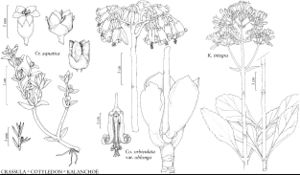Cotyledon
Sp. Pl. 1: 429. 1753.
Gen. Pl. ed. 5., 196. 1754, name conserved ,.
Shrubs, not viviparous, to 8 dm, glabrous [pubescent]. Stems erect, branching, fleshy but somewhat woody. Leaves persistent, cauline, opposite, sessile, not connate basally; blade obovate, laminar, 5–18 cm, fleshy, base not spurred, margins entire; veins not conspicuous. Inflorescences terminal cymes, ultimate branches uniparous. Pedicels present. Flowers pendulous, 5-merous; sepals connate basally, all alike; petals basally erect, distally spreading, connate into 5-gonal tube, orange [red or yellow]; calyx and corolla circumscissile at base in fruit; nectaries adnate to pistils forming cup; stamens 10; filaments adnate to corolla; pistils erect; ovary base rounded; styles longer than or equaling ovary. Fruits erect. Seeds ellipsoid, few-ribbed, finely cross-ribbed. x = 9.
Distribution
Introduced; Calif., Asia (sw Arabia), s, e Africa.
Discussion
Species 11 (1 in the flora).
A. P. de Candolle (1828) narrowed Cotyledon to a natural group of African plants, for which C. H. Uhl (1948) found a distinctive karyotype, with x = 9 rather large chromosomes. H. R. Toelken (1985) further recognized two segregates, Adromischus Lemaire and Tylocodon Toelken, not in the flora area.
Selected References
None.
